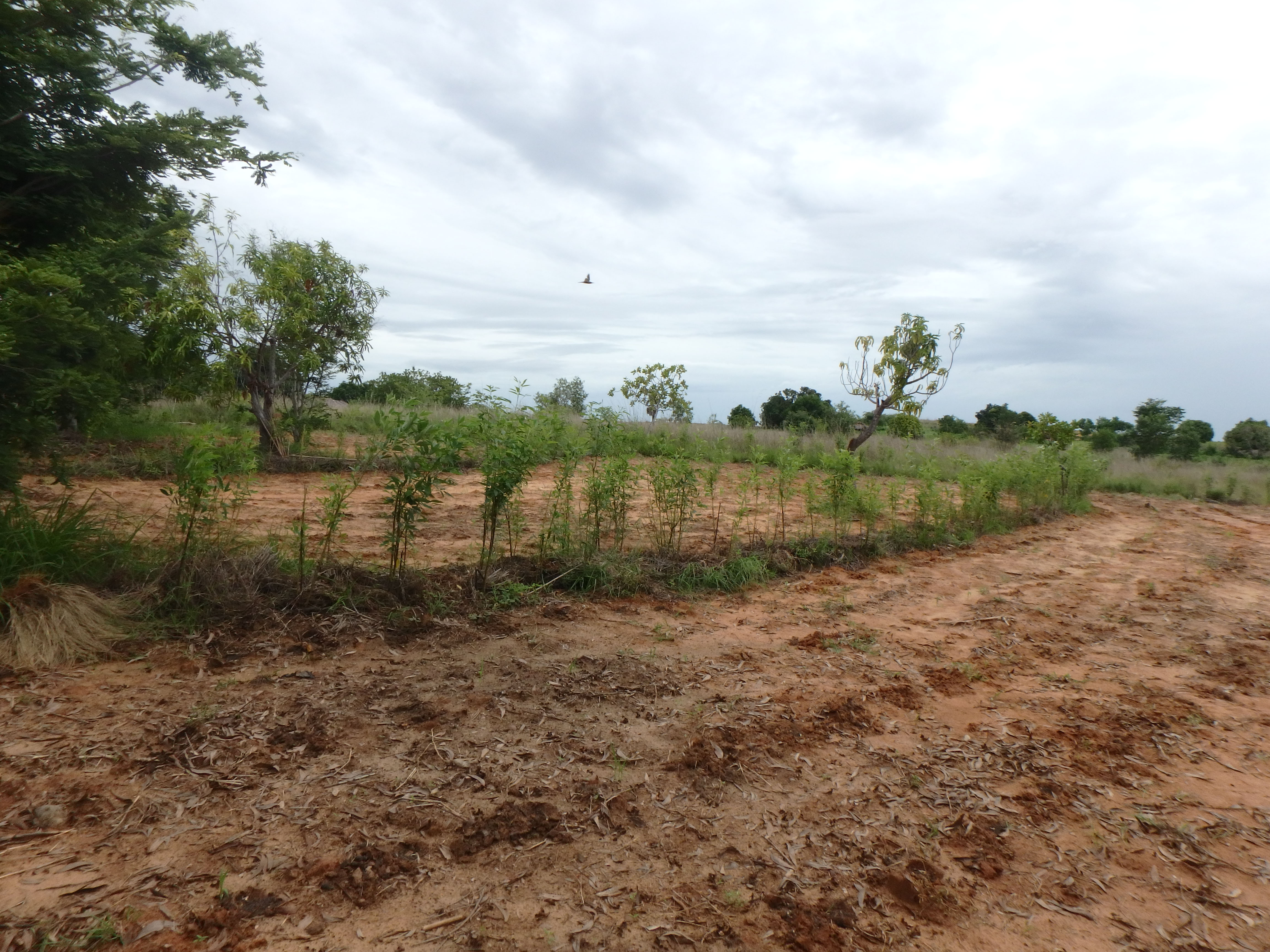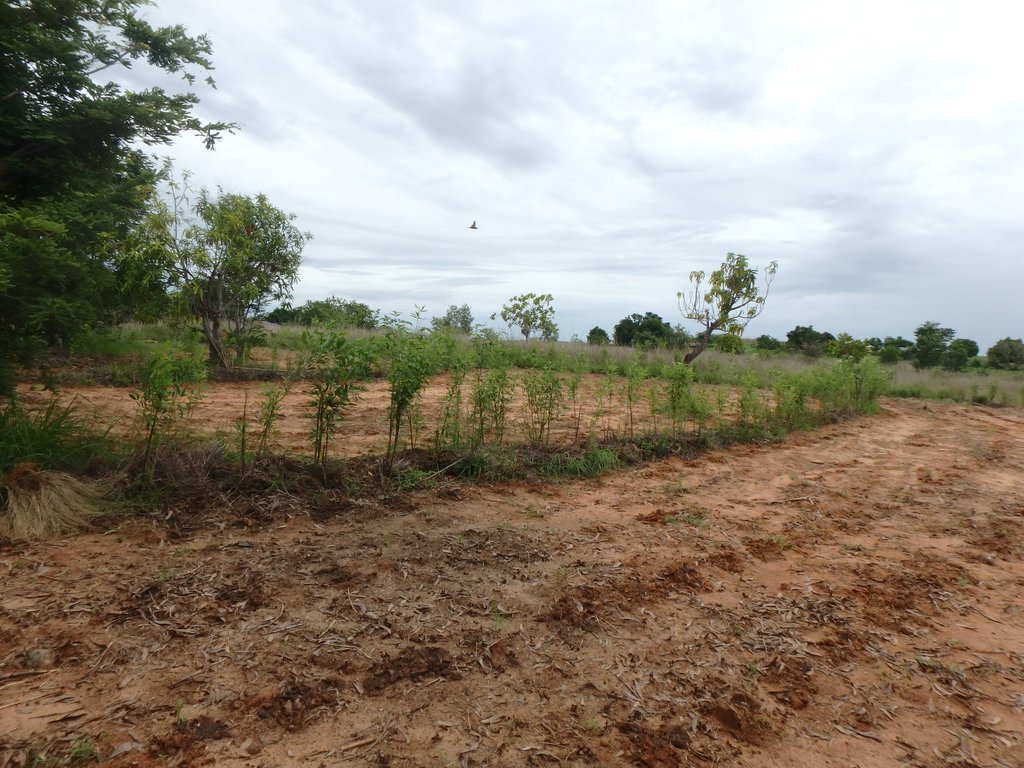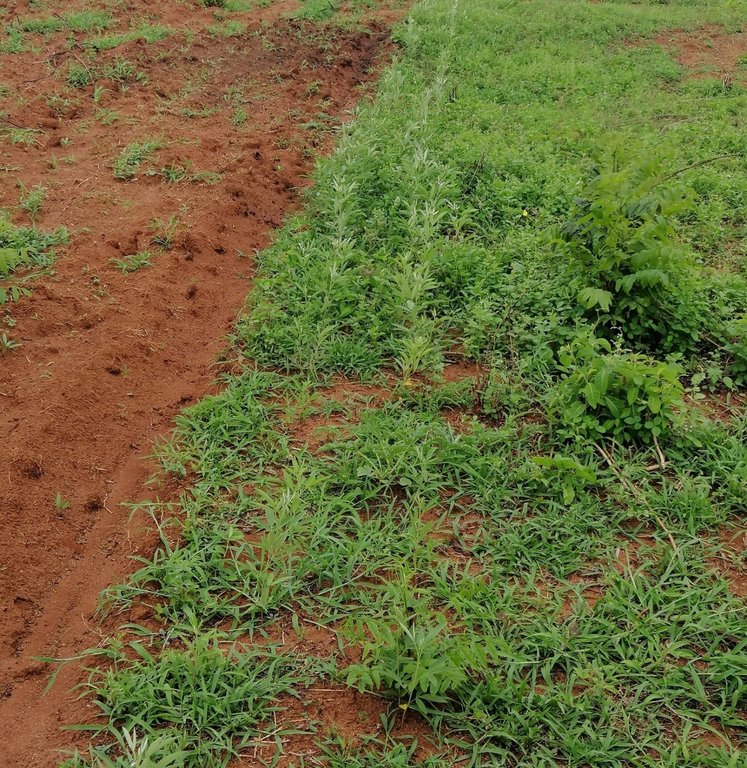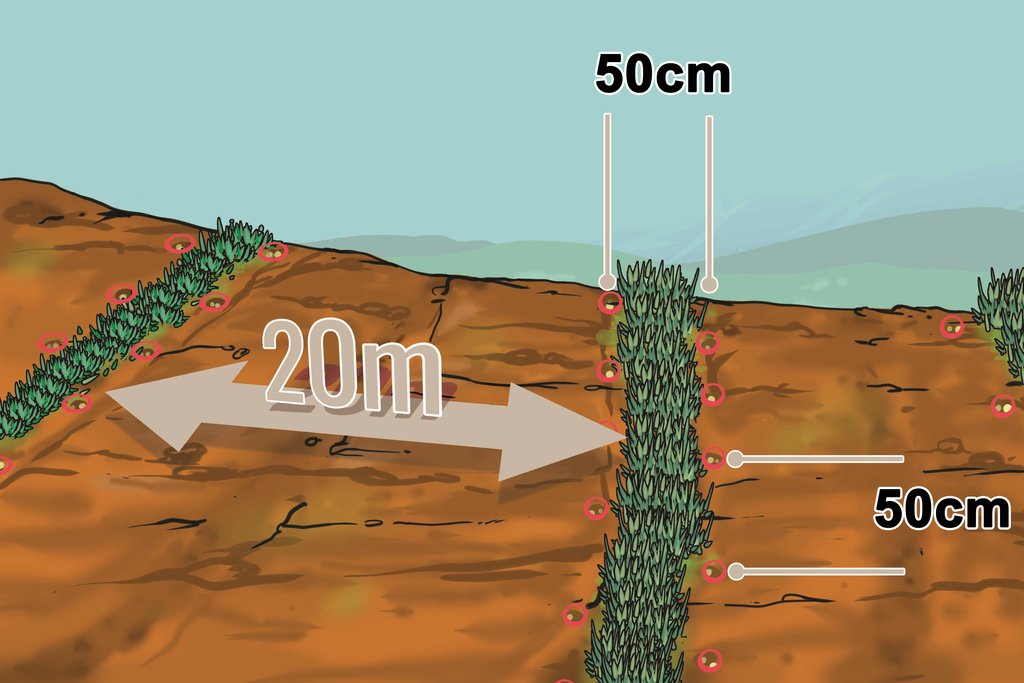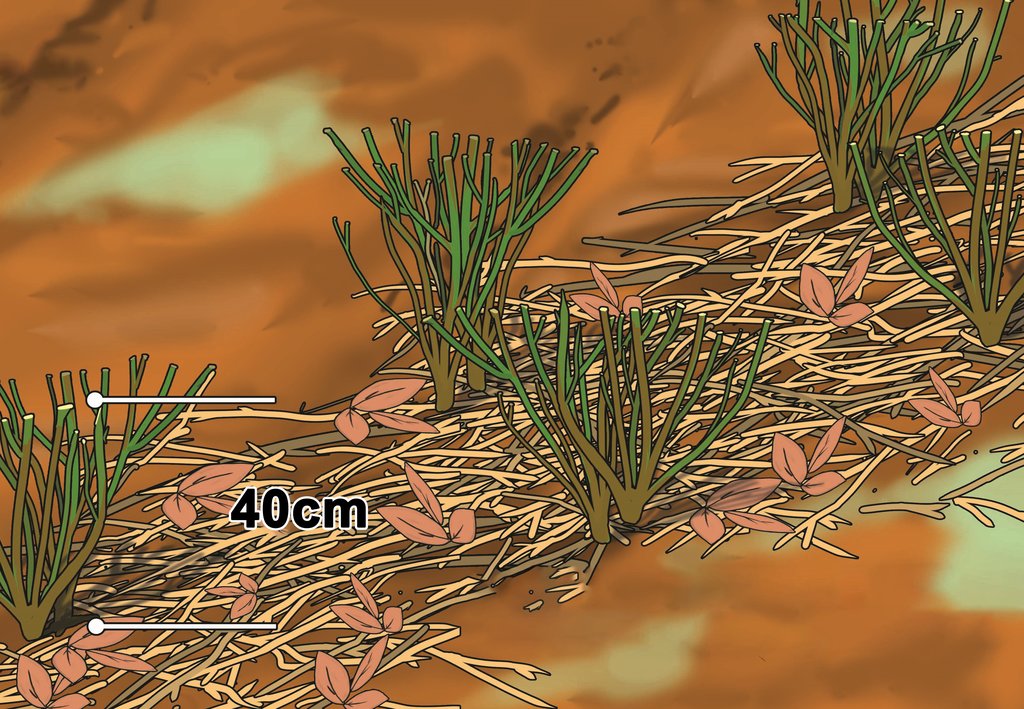Grass strips enriched with Cajanus cajan [Madagascar]
- Creation:
- Update:
- Compiler: Harifidy RAKOTO RATSIMBA
- Editors: Felana Nantenaina RAMALASON, Dimby RAHERINJATOVOARISON, Siagbé Golli, Tahiry Ravivonandrasana, Natacha Rabeary, Tabitha Nekesa, Ahmadou Gaye
- Reviewers: William Critchley, Rima Mekdaschi Studer
Sombin-tany tsy nasaina nohatevenina amin’ny Ambatry na Antsôtry (Madagasikara)
technologies_6480 - Madagascar
View sections
Expand all Collapse all1. General information
1.2 Contact details of resource persons and institutions involved in the assessment and documentation of the Technology
Key resource person(s)
land user:
RAKOTO François Désiré Benjamin
Madagascar
land user:
ANDRIANALISON Dod
Madagascar
land user:
JEAN PIERRE Edward
Madagascar
land user:
RAZAFIMANDIMBY Pascal
Madagascar
land user:
NATHO Jinah
Madagascar
land user:
TOLODRAZA
Madagascar
Name of project which facilitated the documentation/ evaluation of the Technology (if relevant)
Soil protection and rehabilitation for food security (ProSo(i)l)Name of the institution(s) which facilitated the documentation/ evaluation of the Technology (if relevant)
Deutsche Gesellschaft für Internationale Zusammenarbeit (GIZ)1.3 Conditions regarding the use of data documented through WOCAT
The compiler and key resource person(s) accept the conditions regarding the use of data documented through WOCAT:
Yes
1.4 Declaration on sustainability of the described Technology
Is the Technology described here problematic with regard to land degradation, so that it cannot be declared a sustainable land management technology?
No
2. Description of the SLM Technology
2.1 Short description of the Technology
Definition of the Technology:
Grass strips enriched with Cajanus cajan (pigeon pea) are established at regular distances along a slope, ideally following the contour lines. They primarily function as anti-erosion barriers, but also produce food and fodder resources while contributing to soil fertility.
2.2 Detailed description of the Technology
Description:
Grass strips enriched with Cajanus cajan (pigeon pea) are established at regular distances along a slope, ideally following the contour lines. The technology is designed for use on low- to medium-gradient land, referred to as "tanety". During the dry season or at the start of the rainy season, contour lines are laid out by simple surveying equipment using spirit levels about 20 m apart on low slopes or closer for medium slopes. The contour lines also help to guide ploughing. If there is no surveying equipment the strips can simply be laid out across the slope – as estimated by eye – but a surveyed contour is much preferable.
At the time of ploughing (between October and December), the strips - with a minimum width of 50 cm - should be left unploughed to develop natural grasses. Once the plot has been ploughed, pigeon peas can be sown on the edges of the strip every 50 cm, in staggered rows, at a rate of 2-3 seeds per seed hole. Sowing can be done at the start of the rainy season. Pigeon peas can also be planted up to 1 meter apart, still staggered, for increased seed production.
As the season progresses, the grassy strip will develop, and the pigeon peas will start to grow. If more than two pigeon pea plants are observed in a stand, they should be thinned. In the first year, pigeon pea production is generally modest unless the soil is very fertile. The strip should be left in place during the dry season without burning or weeding, serving as continued protection for the plot in the following season. It is then possible either to leave the pigeon peas in place, or to prune them back to 40 cm above the ground, after the first rains (if there is a fear of competition for light with other crops). In this case, the branches and dead leaves can be spread over the plot between strips as mulch or taken to the yard to feed cattle. The wood can be used as firewood.
After three years, the pigeon pea plants die. The primary benefit of this technique is soil protection from erosion and the preservation of soil fertility. The pigeon pea hedge acts also as a useful windbreak providing food, fodder, and wood. It also ensures a substantial production of biomass beneficial for the soil. Because pigeon pea is a legume, it fixes atmospheric nitrogen. Furthermore, the fallen leaves of pigeon pea fertilize the plot. It is important to note that pigeon pea pods are vulnerable to insect attack.
2.3 Photos of the Technology
2.5 Country/ region/ locations where the Technology has been applied and which are covered by this assessment
Country:
Madagascar
Region/ State/ Province:
Boeny
Further specification of location:
Ambondromamy, Belobaka
Specify the spread of the Technology:
- evenly spread over an area
If precise area is not known, indicate approximate area covered:
- < 0.1 km2 (10 ha)
Is/are the technology site(s) located in a permanently protected area?
No
Map
×2.6 Date of implementation
Indicate year of implementation:
2020
If precise year is not known, indicate approximate date:
- less than 10 years ago (recently)
2.7 Introduction of the Technology
Specify how the Technology was introduced:
- through projects/ external interventions
Comments (type of project, etc.):
GIZ ProSoil Madagascar
3. Classification of the SLM Technology
3.1 Main purpose(s) of the Technology
- improve production
- reduce, prevent, restore land degradation
- protect a watershed/ downstream areas – in combination with other Technologies
- preserve/ improve biodiversity
- create beneficial economic impact
3.2 Current land use type(s) where the Technology is applied
Land use mixed within the same land unit:
No

Cropland
- Annual cropping
- Perennial (non-woody) cropping
Annual cropping - Specify crops:
- cereals - maize
- cereals - rice (upland)
- cereals - sorghum
- legumes and pulses - peas
- oilseed crops - groundnuts
- root/tuber crops - cassava
- vegetables - melon, pumpkin, squash or gourd
- Mucuna
- Pigeon pea or Cajanus
Number of growing seasons per year:
- 1
Is intercropping practiced?
Yes
If yes, specify which crops are intercropped:
Maize and melon
Maize and mung bean
Maize and mucuna
Maize and peanut
Dryland rice and pigeon pea
Is crop rotation practiced?
Yes
If yes, specify:
Combination of cereals and legumes or vegetables in Year n, then rice and pigeon peas in Year n+1, then cassava in Year n+2, and so on.
3.3 Has land use changed due to the implementation of the Technology?
Has land use changed due to the implementation of the Technology?
- Yes (Please fill out the questions below with regard to the land use before implementation of the Technology)
Land use mixed within the same land unit:
No

Unproductive land
Specify:
Savannah
Remarks:
These are lands that have not been farmed yet, essentially composed of (grassy) savannah.
3.4 Water supply
Water supply for the land on which the Technology is applied:
- rainfed
3.5 SLM group to which the Technology belongs
- improved ground/ vegetation cover
- integrated soil fertility management
- cross-slope measure
3.6 SLM measures comprising the Technology

agronomic measures
- A1: Vegetation/ soil cover
- A2: Organic matter/ soil fertility
- A3: Soil surface treatment

vegetative measures
- V1: Tree and shrub cover
- V2: Grasses and perennial herbaceous plants
3.7 Main types of land degradation addressed by the Technology

soil erosion by water
- Wt: loss of topsoil/ surface erosion

soil erosion by wind
- Et: loss of topsoil
3.8 Prevention, reduction, or restoration of land degradation
Specify the goal of the Technology with regard to land degradation:
- reduce land degradation
- restore/ rehabilitate severely degraded land
4. Technical specifications, implementation activities, inputs, and costs
4.1 Technical drawing of the Technology
Technical specifications (related to technical drawing):
A grass strip should have a minimum width of 50 cm. The recommended distances between these strips vary based on the slope. For gentle slopes, a distance of around 20 m is advised. On steeper slopes, it is recommended to reduce the distance between strips. Maintain a minimum distance of 5 m to facilitate cultivation between the strips. In cases of steeper slopes, it is recommended to use fencing instead of creating grassed strips separated by crops.
The soil is plowed between October and December. Pigeon peas can then be sown on the edges of the strip, with a spacing of 50 cm in staggered rows, at a rate of 2-3 seeds per stake. Sowing is typically done at the onset of the rainy season.
Pigeon peas can be planted up to 1 m apart, but always with a staggered arrangement for increased seed production. Weeding around the seedpods is necessary initially to prevent competition with neighboring crops.
Author:
GIZ ProSoil Madagascar, GSDM
Date:
05/19/2022
Technical specifications (related to technical drawing):
At the start of the new rainy season, pigeon peas should be pruned to a height of 40 cm above the ground.
Author:
GIZ ProSol Madagascar, GSDM
Date:
05/19/2022
4.2 General information regarding the calculation of inputs and costs
Specify how costs and inputs were calculated:
- per Technology area
Indicate size and area unit:
1 hectare
other/ national currency (specify):
ariary
If relevant, indicate exchange rate from USD to local currency (e.g. 1 USD = 79.9 Brazilian Real): 1 USD =:
4300.0
Indicate average wage cost of hired labour per day:
5000
4.3 Establishment activities
| Activity | Timing (season) | |
|---|---|---|
| 1. | Seeding | November-December |
4.4 Costs and inputs needed for establishment
| Specify input | Unit | Quantity | Costs per Unit | Total costs per input | % of costs borne by land users | |
|---|---|---|---|---|---|---|
| Labour | Seeding | man-day | 2.0 | 5000.0 | 10000.0 | 100.0 |
| Plant material | Pigeon pea seed | kg | 3.5 | 4000.0 | 14000.0 | |
| Total costs for establishment of the Technology | 24000.0 | |||||
| Total costs for establishment of the Technology in USD | 5.58 | |||||
If land user bore less than 100% of costs, indicate who covered the remaining costs:
GIZ ProSoil Madagascar
4.5 Maintenance/ recurrent activities
| Activity | Timing/ frequency | |
|---|---|---|
| 1. | Trimming/cutting | Once a year in November or December |
4.6 Costs and inputs needed for maintenance/ recurrent activities (per year)
| Specify input | Unit | Quantity | Costs per Unit | Total costs per input | % of costs borne by land users | |
|---|---|---|---|---|---|---|
| Labour | Trimming/cutting | man-day | 4.0 | 5000.0 | 20000.0 | 100.0 |
| Total costs for maintenance of the Technology | 20000.0 | |||||
| Total costs for maintenance of the Technology in USD | 4.65 | |||||
4.7 Most important factors affecting the costs
Describe the most determinate factors affecting the costs:
Labour for implementation.
5. Natural and human environment
5.1 Climate
Annual rainfall
- < 250 mm
- 251-500 mm
- 501-750 mm
- 751-1,000 mm
- 1,001-1,500 mm
- 1,501-2,000 mm
- 2,001-3,000 mm
- 3,001-4,000 mm
- > 4,000 mm
Specify average annual rainfall (if known), in mm:
1400.00
Agro-climatic zone
- sub-humid
5.2 Topography
Slopes on average:
- flat (0-2%)
- gentle (3-5%)
- moderate (6-10%)
- rolling (11-15%)
- hilly (16-30%)
- steep (31-60%)
- very steep (>60%)
Landforms:
- plateau/plains
- ridges
- mountain slopes
- hill slopes
- footslopes
- valley floors
Altitudinal zone:
- 0-100 m a.s.l.
- 101-500 m a.s.l.
- 501-1,000 m a.s.l.
- 1,001-1,500 m a.s.l.
- 1,501-2,000 m a.s.l.
- 2,001-2,500 m a.s.l.
- 2,501-3,000 m a.s.l.
- 3,001-4,000 m a.s.l.
- > 4,000 m a.s.l.
Indicate if the Technology is specifically applied in:
- concave situations
5.3 Soils
Soil depth on average:
- very shallow (0-20 cm)
- shallow (21-50 cm)
- moderately deep (51-80 cm)
- deep (81-120 cm)
- very deep (> 120 cm)
Soil texture (topsoil):
- coarse/ light (sandy)
- medium (loamy, silty)
Soil texture (> 20 cm below surface):
- medium (loamy, silty)
- fine/ heavy (clay)
Topsoil organic matter:
- medium (1-3%)
5.4 Water availability and quality
Ground water table:
5-50 m
Availability of surface water:
medium
Water quality (untreated):
poor drinking water (treatment required)
Water quality refers to:
ground water
Is water salinity a problem?
No
Is flooding of the area occurring?
No
5.5 Biodiversity
Species diversity:
- medium
Habitat diversity:
- low
Comments and further specifications on biodiversity:
The region is home to numerous species of flora and fauna, some of which are native. Nevertheless, this quantity remains moderate compared to other regions of the island. In terms of habitats, approximately 20% of the area can serve as a habitat for this biodiversity (forests, bodies of water, mangroves, etc.), which remains fairly low.
5.6 Characteristics of land users applying the Technology
Sedentary or nomadic:
- Sedentary
Market orientation of production system:
- mixed (subsistence/ commercial)
Off-farm income:
- less than 10% of all income
Relative level of wealth:
- poor
- average
Individuals or groups:
- individual/ household
- groups/ community
Level of mechanization:
- manual work
- animal traction
Gender:
- women
- men
Age of land users:
- youth
- middle-aged
5.7 Average area of land used by land users applying the Technology
- < 0.5 ha
- 0.5-1 ha
- 1-2 ha
- 2-5 ha
- 5-15 ha
- 15-50 ha
- 50-100 ha
- 100-500 ha
- 500-1,000 ha
- 1,000-10,000 ha
- > 10,000 ha
Is this considered small-, medium- or large-scale (referring to local context)?
- small-scale
5.8 Land ownership, land use rights, and water use rights
Land ownership:
- individual, not titled
- individual, titled
Land use rights:
- individual
Water use rights:
- open access (unorganized)
Are land use rights based on a traditional legal system?
Yes
Specify:
The individual who takes care of the land owns it.
5.9 Access to services and infrastructure
health:
- poor
- moderate
- good
education:
- poor
- moderate
- good
technical assistance:
- poor
- moderate
- good
employment (e.g. off-farm):
- poor
- moderate
- good
markets:
- poor
- moderate
- good
energy:
- poor
- moderate
- good
roads and transport:
- poor
- moderate
- good
drinking water and sanitation:
- poor
- moderate
- good
financial services:
- poor
- moderate
- good
6. Impacts and concluding statements
6.1 On-site impacts the Technology has shown
Socio-economic impacts
Production
crop production
crop quality
fodder production
fodder quality
Income and costs
expenses on agricultural inputs
workload
Socio-cultural impacts
food security/ self-sufficiency
Ecological impacts
Water cycle/ runoff
surface runoff
Soil
soil moisture
soil cover
soil loss
Biodiversity: vegetation, animals
Vegetation cover
biomass/ above ground C
Specify assessment of on-site impacts (measurements):
These are estimates by the farmers.
6.2 Off-site impacts the Technology has shown
downstream siltation
Comments/ specify:
As a result, less siltation of downstream rice fields is a positive factor.
damage on neighbours' fields
Specify assessment of off-site impacts (measurements):
These are estimates by the farmers.
6.3 Exposure and sensitivity of the Technology to gradual climate change and climate-related extremes/ disasters (as perceived by land users)
Gradual climate change
Gradual climate change
| Season | increase or decrease | How does the Technology cope with it? | |
|---|---|---|---|
| annual temperature | increase | moderately | |
| annual rainfall | decrease | not well |
Climate-related extremes (disasters)
Meteorological disasters
| How does the Technology cope with it? | |
|---|---|
| tropical storm | moderately |
Climatological disasters
| How does the Technology cope with it? | |
|---|---|
| forest fire | not well |
Biological disasters
| How does the Technology cope with it? | |
|---|---|
| insect/ worm infestation | not well |
6.4 Cost-benefit analysis
How do the benefits compare with the establishment costs (from land users’ perspective)?
Short-term returns:
slightly positive
Long-term returns:
positive
How do the benefits compare with the maintenance/ recurrent costs (from land users' perspective)?
Short-term returns:
slightly positive
Long-term returns:
positive
6.5 Adoption of the Technology
- single cases/ experimental
6.6 Adaptation
Has the Technology been modified recently to adapt to changing conditions?
Yes
If yes, indicate to which changing conditions it was adapted:
- climatic change/ extremes
6.7 Strengths/ advantages/ opportunities of the Technology
| Strengths/ advantages/ opportunities in the land user’s view |
|---|
| Reduced water and wind erosion on the soil surface |
| A source of additional income (sale of seeds). The seeds (green or dried) are also consumed by farmers as a delicacy. |
| Fodder for livestock or green manure for the soil (leaves). The branches are also used as cooking fuel. |
| Strengths/ advantages/ opportunities in the compiler’s or other key resource person’s view |
|---|
| This technique makes it possible to combine effective soil protection and food production without needing to work the soil or sow seeds for three years. |
6.8 Weaknesses/ disadvantages/ risks of the Technology and ways of overcoming them
| Weaknesses/ disadvantages/ risks in the land user’s view | How can they be overcome? |
|---|---|
| Pigeon pea is vulnerable to insect attack (especially to its pods). | Treat with biocides. |
| A fairly substantial amount of work is required if the land is large and uneven, to make sure that the strips follow the contour lines. | Hire labour to carry out the work, but this means drawing on savings. |
| A lack of commercial openings for pigeon pea grain. | Work on marketing this species to turn it into a source of income. |
7. References and links
7.1 Methods/ sources of information
- field visits, field surveys
Six (6) fields visited
- interviews with land users
Six (6) farmers interviewed
- compilation from reports and other existing documentation
GIZ ProSoil Madagascar data sheet
When were the data compiled (in the field)?
31/01/2023
7.2 References to available publications
Title, author, year, ISBN:
Région Boeny, 2016, "Schéma Régional d’Aménagement du Territoire de la Région Boeny"
Available from where? Costs?
Boeny Region Hotel
Title, author, year, ISBN:
GIZ ProSol Madagascar, 2022, "Livret des Paysans Relais"
Available from where? Costs?
Madagascar GIZ ProSol
Title, author, year, ISBN:
GIZ ProSol Madagascar, 2022, Poster "Bandes enherbées enrichies de pois d'Angole"
Available from where? Costs?
Madagascar GIZ ProSol
Title, author, year, ISBN:
GRET, 2015, "Pratiques agroécologiques et agroforestières en zone tropicale humide", Fiche N°15 Bandes enherbées en courbe de niveau
Available from where? Costs?
https://gret.org/publication/pratiques-agroecologiques-et-agroforestieres-en-zone-tropicale-humide/
7.3 Links to relevant online information
Title/ description:
"Bandes végétalisées naturelles garnies de pois d’Angole"
URL:
https://soatany.org/fiches-techniques/
Title/ description:
GSDM, "Rotation de culture sur tanety à base de cajanus"
URL:
https://gsdm-mg.org/wp-content/files/Fiche_technique_Cajanus_GSDM__TFNAC.pdf
Links and modules
Expand all Collapse allLinks
No links
Modules
No modules


